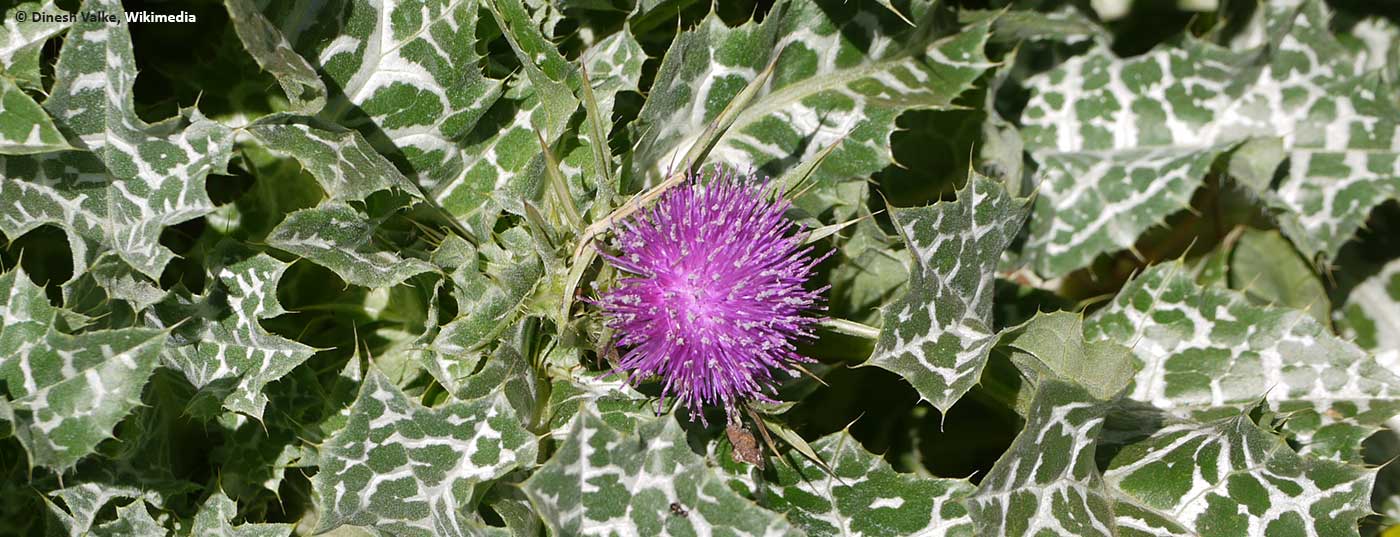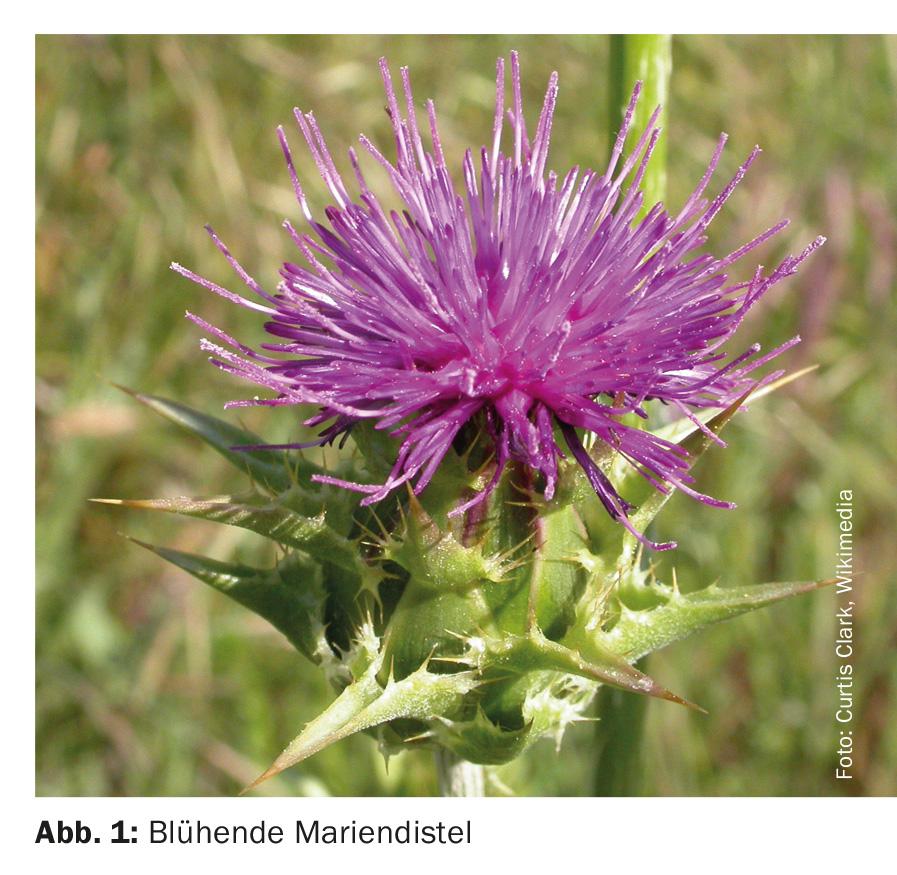Pharmacological and clinical studies support the efficacy of milk thistle extracts and silymarin – an overview of diseases and efficacy studies.
Various pharmacological and clinical studies support the efficacy of milk thistle extracts and primarily silymarin, the main active ingredient of milk thistle. Corresponding preparations are therefore suitable for natural and effective treatment of liver damage of various origins. The main liver diseases include:
- Acute hepatitis
- chronic hepatits C
- Cirrhosis of the liver
Hepatitis A: Hepatitis A, transmitted fecal-orally, for example through contaminated food, is an infectious liver disease, but unlike hepatitis B and C, it does not become chronic. The disease usually lasts less than two months, but can last for several months. Typical symptoms include jaundice, liver swelling, fever, nausea, fatigue, pain, vomiting, lack of appetite, light-colored stools, dark urine.
Hepatitis B: Hepatitis B is transmitted by blood, saliva, or sperm, and shows similar symptoms to hepatitis A. Unlike hepatitis A, hepatitis B can become chronic in about 5% of affected individuals and lead to severe liver problems such as cirrhosis, liver failure, or hepatocellular carcinoma.
Hepatitis C: In the case of infection caused by the hepatitis C virus, most patients do not experience typical symptoms. The disease is manifested by fatigue, nausea, loss of appetite, muscle and joint pain, and weight loss. Hepatitis C is dangerous in the long term because it can develop into cirrhosis or liver cancer and require transplantation.
Cirrhosis of the liver: Cirrhosis of the liver is a chronic liver disease in which the lobular and vascular architecture is fibrotically destroyed. Affected patients are tired and fatigued, feel pressure in the right upper abdomen, nausea, lose weight. Further, exhaustion and meteorism occur. Alcohol is often involved.
Medicinal plants for liver problems
There are a number of medicinal plants that can be used for liver problems. These include primarily the artichoke (Cynara scolymus), dandelion (Taraxacum officinale), celandine (Chelidonium majus) and milk thistle (Silybum marianum). However, there are also possible applications with yarrow (Achillea millefolium) and chicory (Cichorium intybus).
Milk thistle (Silybum marianum) is a plant up to 150 cm high, which grows from the eastern Mediterranean to southern Russia and Iran. Its former name was Carduus marianus.
Ingredients, pharmacology of milk thistle
The main ingredient of milk thistle is silymarin, a complex of substances of which silibinin (silybin) is the most active substance. The main effect is antihepatotoxic stabilization of the cell membrane. Another effect of Silybum marianum is based on the stimulation of the regenerative capacity of hepatocytes. Furthermore, silymarin hinders the penetration of toxic noxae and the loss of cellular components such as transaminases. This occurs by reducing the oxidation and transport processes in the cell membrane. Silymarin also stimulates the formation of new hepatocytes [1]. The radical scavenging properties of silymarin appear to play an important role in this process [2].
Studies
Various pharmacological and clinical studies addressed the efficacy of milk thistle and silymarin, respectively, for the treatment of various liver diseases. A review paper was also published earlier this year [3]. The results of published studies are presented below.
Hepatitis A, B and C
Wei et al. published a meta-analysis in 2013 on the efficacy of combinations of silymarin with antiviral agents (lamivudine and interferon) for the treatment of chronic hepatitis B [4]. The evaluated studies showed similar efficacy of silymarin and antiviral agents in terms of normalization of serum AST and ALT levels and in terms of a negative conversion rate of serum HBsAg. The combination of silymarin and antiviral agents was more effective than the antiviral agents alone.
In another meta-analysis by Yang et al. In 2014 [5], the efficacy of silymarin in chronic hepatitis C was investigated. It was shown that silymarin was able to reduce the serum RNA level of hepatitis C viruses, but not significantly. However, for this effect, silymarin had to be administered both orally and intravenously.
Ferenci et al. were able to show in 2008 that silybin can reduce viral load by logarithm 3 to 4 in pegyinterferon-resistant patients by blocking the function of HCV polymerase [6].
Alcohol-related liver damage
Alcohol abuse is among the most common causes of hepatopathies worldwide by impairing mitochondrial functioning through lipid peroxidation and intracellular accumulation of acetaldehyde.
Federico et al. were able to show in 2015 in an in vitro pharmacological study that a silybin-phosphatidylcholine complex had a positive effect on cell viability in the oxidative stress state by reducing both lipid peroxidation and cell necrosis [7].
Several studies have shown that silymarin and the silybin-phosphatidylcholine complex can optimize mitochondrial metabolic processes as well as electron transport [8–11]. This increases intracellular superoxide dismutase and decreases MAO activity, leading to a decrease in intracellular reactive oxygen compounds and thus improving mitochondrial function.
Non-alcohol-related liver damage
Non-alcohol related liver damage (NAFLD) has experienced exponential growth in the Western Hemisphere in recent years. Various studies have attempted to explain the relationship between the use of silymarin/silybin and its efficacy. Silymarin/silybin exert antagonism on the progression of non-alcohol-related liver damage.
Butorova et al. investigated the efficacy of silymarin in NAFLD in an open-label, randomized, parallel-group study [12]. The authors concluded from the results that therapy with 140 mg silymarin 3× daily is an effective and safe hepatoprotector in the case of NAFLD and leads to significant improvement in clinical and biochemical parameters.
Cirrhosis of the liver
Advanced fibrosis of liver cells is irreversible. However, silymarin interferes with the fibrogenetic process. A pharmacological study [13] demonstrated that in CCl4-treated rats, silymarin can reduce the progression of the fibrogenetic process at an early stage.
Conclusion: Milk thistle is a well-studied and effective medicinal plant for various liver disorders.
Take-Home Messages
- There are various medicinal plants with a folk medicine tradition for the treatment of liver diseases. These include the artichoke, dandelion and celandine. The milk thistle, Silybum marianum, has also been the subject of particularly intensive research. This article provides an overview of liver diseases and their treatment options with milk thistle.
Literature:
- Wellington K, Jarvis B: Silymarin; a review of its clinical properties in the management of hepatic disorders. Bio Drugs 2001(7); 15: 465-489.
- Iten F, et al: Silymarin in the treatment of liver diseases, phytotherapy 2003(1); 3: 18-24.
- Federico A, Dallio M, Loguercio C: Silymarin/Silybin and Chronic Liver Dis-ease: A Marriage of Many Years, Molecules. 2017(2); 22. pii: E191. doi: 10.3390/molecules22020191
- Wei F, et al.: Meta-Analysis: Silymarin and its combination for the treatment of chronic hepatitis B, Eur. J. Clin. Microbiol. infect. Dis. 2013; 32: 657-669.
- Yang Z, et al: Effects and tolerance of silymarin (milk thistle) in chronic hepatitis C virus infection patients: A meta-analysis of randomized control trials, Biomed. Res. Int. 2014, 2014, 941085.
- Ferenci P, et al: Silibinin is a potent antiviral agent in patients with chronic hepatitis C not responding tu pegylated interferon ribavirin therapy, Gastronenterology 2008; 135: 1561-1567.
- Federico A. et al: Silybin-Phosphatidylcholine Complex Protects Human Gastric and Liver Cells from Oxidative Stress, In Vivo 2015;
- 29: 569-575.
- Rolo A.P. et al: Protection against post-ischemic mitochondrial injury in rat liver by silymarin or TUDC, Hepatol. Res. 2003;
- 26: 217-224.
- Detaille D. et al: Interrelation between the inhibition of glycolytic flux by silibinin and the lowering of mitochondrial ROS production in perfused rat hepatocytes, Life Sci. 2008; 82: 1070-1076.
- Grattagliano I. et al: A silybin-phospholipids complex counteracts rat fatty liver degeneration and mitochondrial oxidative changes, World J. Gastroenterol. 2013; 19: 3007-3017
- Mazzio E.A. et al: Food constituents attenuate monoamine oxidae activity and peroxide levels in C6 astrocyte cells, Plant Med. 1998; 64: 603-606.
- Butorova L.I, et al: Potential for the Use of Legalon® in Non-Alcoholic Fatty Liver Desease, Experimental and Clinical Gastroenterology 2010; 3: 85-91.
- Clichici S, et al: Silymarin inhibits the progression of fibrosis in the early stage of liver injury in CCl4-treated rats, J. Med. Food 2015; 18: 290-298.
HAUSARZT PRAXIS 2017; 12(5): 3-4












